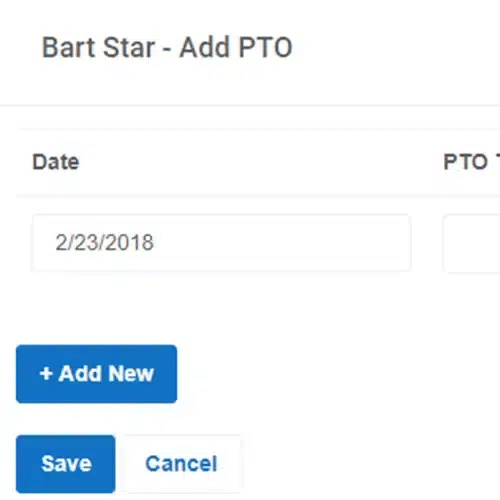Why Does Your Nonprofit Need Time Clock Software?

As a nonprofit organization, you are committed to positively impacting your community and achieving your mission.
However, managing a nonprofit comes with its own set of unique challenges. Employee time tracking and scheduling are often thought of as profit-driven necessities.
With limited resources, finding efficient and cost-effective solutions to these challenges is crucial.
That’s where time clock software comes in. Time clock software can be an invaluable tool that helps nonprofits achieve their goals.
Here are the benefits of using time clock software for non-profit organizations:
1. Track Employee Productivity: Time clock software can help you track employee productivity by accurately recording their work hours and activities.
Best Time Clock Software: Buddy Punch
2. Excellent Reporting: Time clock software provides excellent reporting capabilities, allowing you to generate detailed reports on employee work hours, program costs, and other key metrics.
3. Improve Program Management: It can help you improve program management by providing real-time insights into employee time and activity.
4. Improved Data Insights: Time clock software provides valuable insights into employee productivity and program performance. This information can help you make informed decisions about staffing, budgeting, and resource allocation, leading to more effective programs and improved outcomes.
We will explore what is a non-profit organization, what is time clock software for non-profits, why time clock software is important for nonprofits, and how nonprofit time clocking works.
We will also discuss the reasons for using time clocking for nonprofit organizations.
- What Is a Nonprofit Organization?
- Why Does A Nonprofit Organization Need Time Clock Software? Top 5 Reasons
- What Is A Time Clock Software For Nonprofits?
- Why Is Time Clocking Important For Nonprofits?
- How Nonprofit Timekeeping Works?
- How Can You Track Volunteer Hours with Time Clock Software?
Try Buddy Punch For Free
What Is a Nonprofit Organization?
A nonprofit organization is a group focused on making a difference in their community. They are tax-exempt and operate similarly to a business.
Nonprofits can include nonprofit organizations, charitable efforts, and even credit unions. Some examples of large nonprofit organizations include the American Red Cross and the Make-A-Wish Foundation.
Nonprofits are typically organized under IRS code section 501(c)(3). This section code allows organizations to operate as tax-exempt entity. Revenue generated from sales serves the organization’s mission and is not considered profit.
Nonprofits have both employees and volunteers whose time needs to be scheduled and tracked. In some situations, tracking hours is a crucial function of payroll, as well as compliance.
It is often said that time tracking and scheduling are more critical for nonprofits than for commercial organizations.
Nonprofits are not exempt from laws that fall under the Fair Labor Standard Act. They must track employees’ time and pay them accordingly, and failure to do so could result in fines and an audit.
Why Does A Nonprofit Organization Need Time Clock Software? Top 5 Reasons
The time clock is essential for nonprofit organizations as it helps track employee and volunteer work accurately.
Here are the top five reasons why nonprofit organizations should use time clock software:
1. Compliance Tracking

An automated time tracker can substantially benefit your nonprofit organization by ensuring industry regulation compliance.
Time tracking is a crucial aspect of maintaining tax-exempt status, which is why governmental and regulatory bodies closely scrutinize the operations of nonprofit organizations, conducting regular audits to ensure they comply with current rulings and regulations.
Without the capacity to handle such an audit, nonprofit organizations may struggle to maintain their operations.
Tracking employee and volunteer hours can be a challenging and time-consuming task.
However, automated time tracking and scheduling can make this process seamless and efficient.
Automated time tracking measures the time an employee or volunteer has spent working, and alerts and notifications can be set up to monitor time spent over a specific period.
Additionally, scheduling features can help you avoid exceeding your budget by managing shift assignments such as location, department, or position.
Here are some specific benefits of compliance tracking:
- Avoiding Penalties: Time clocking software can help organizations track employee hours and ensure they comply with minimum wage and overtime laws.
- Improving Record-Keeping: Time clocking can simplify this process by automatically recording employee hours and generating reports that can be used for compliance purposes.
- Ensuring Fair Labor Practices: It can help organizations track employee hours and ensure they are paid fairly. This can help organizations maintain their credibility and reputation as ethical employers.
- Mitigating Risk: Time-tracking software can help organizations mitigate these risks by ensuring that they are complying with labor laws and regulations and treating their employees fairly.
- Facilitating Audits: By using time clocking software to track employee hours and maintain accurate records, organizations can provide auditors with the information they need to verify compliance with labor laws and regulations.
2. Maintain Records
It is the law for all organizations, including nonprofits, to accurately document their employees’ or volunteers’ hours. The US Department of Labor requires you to retain time cards for employees for at least two years.
Remember that this law only applies to non-exempt employee time tracking. Non-exempt employees are usually paid hourly and can receive overtime pay.
Exempt employees are paid a fixed salary and cannot receive overtime when working more than 40 hours per week.
FLSA wages and hours lawsuits are on the rise, which can result in costly payouts if the plaintiff wins.

If an employee suspects they have been shorted hours on their paycheck, they have a right to file a complaint with the Department of Labor. Once a claim has been submitted, an investigation is likely to be launched.
If you are selected for an inquiry, you must have documentation to show that your employees have been properly paid.
Maintaining records is not merely a suggestion; it can be the difference between your organization continuing to run or being put out of business.
Maximizing a budget is a crucial part of any nonprofit. With the help of time clock software, you can reduce your labor and payroll costs, allowing you to reallocate those resources for something more critical such as your mission.
Here are some specific benefits of record-keeping:
- Compliance: As mentioned earlier, maintaining accurate records is essential for nonprofit organizations to comply with labor laws and regulations. Time clocking software can automate this process, making tracking employee hours, breaks, and overtime easy.
- Payroll Management: Time clocking software can help nonprofit organizations calculate employee wages and generate pay stubs and reports.
- Budgeting: By tracking employee hours and labor costs, nonprofit organizations can better understand their expenses and make informed decisions about resource allocation.
- Reporting: It can generate reports and analytics that can be used to demonstrate impact and support fundraising efforts.
- Legal Protection: Maintaining accurate records can also protect nonprofit organizations.
In addition to these benefits, time clock software offers various features and integrations that can further enhance your nonprofit organization’s operations:
- Track Time: The software allows you to track time entries and monitor employee hours easily.
- Employee Scheduling: It helps in managing team members’ schedules efficiently.
- Expense Tracking: You can also track expenses related to projects or activities.
- Project Management: The software often includes project management capabilities to streamline workflows and improve efficiency.
- Time Management: With time tracking tools and features, you can effectively manage and allocate time resources.
- Integrations: Time clock software often integrates with other systems, such as accounting software and spreadsheets, to streamline processes and improve accuracy.
- All-in-One Solution: Many time clock software solutions offer comprehensive features, combining time tracking, scheduling, expense management, and more in a single platform.
- Mobile App: Some time clock software provides a mobile app, allowing employees to track time and access relevant features conveniently.
- GPS Location: Certain time clock software includes GPS location tracking, which can be useful for organizations with employees working in the field.
- Pricing: Different software providers offer various pricing plans to cater to nonprofit organizations’ specific needs and budgets.
- Billable: The software often allows you to track billable hours accurately, making it easier to invoice clients or funders.
Ready to start a free trial?
No credit card required, all features included.
By implementing time clock software, nonprofit organizations can streamline their time management, improve compliance, enhance payroll processes, and optimize their budgeting and reporting efforts.
These benefits and the diverse features and integrations make time clock software an essential tool for nonprofits.
3. Maximize Budgets

As a nonprofit organization, maximizing efficiency and maximizing the most of every penny is crucial.
By doing so, you can demonstrate to your donors that their contributions are being utilized effectively and ensure that the resources at your disposal are being put towards achieving your community objectives.
This is why it is important to maximize your budget. Automated time clock software can help you reduce labor expenses and optimize the use of human capital.
Punch-in restrictions can help you limit where, how, and when employees can punch in or out. By restricting employee punching, you can minimize any unplanned overtime that could impact your budget.
Other unplanned expenses, such as time theft, can also be avoided. Geofencing and biometrics can ensure the right employees are on the job at the right time. With little effort, the savings to your organization can be substantial.
Scheduling tools can help you cut waste as well as overlap. If your nonprofit schedules employees or volunteers for special events or busy times of the year, overstaffing, overlap, and understaffing can be big problems.
Scheduling can help you manage employees so that there aren’t too many people working at the wrong time.
It can also help you avoid understaffing based on historical data and allow you to make more informed decisions.
4. Save Time & Money

Saving time and money are always a top priority for any nonprofit. Time tracking apps can assist you in saving a great deal of time.
If collecting time cards or running payroll takes more than a few minutes, it is worth investing in time clock software.
For example, it can eliminate the need for manual time tracking and reduce errors in payroll processing. This, in turn, can save organizations valuable resources and free up time for more critical tasks, such as fundraising or program development.
That means you’ll have more resources to help you build your community or save the world.
Accurately tracking paid time off is beneficial to employees but also to a nonprofit. You need to track this information to avoid paying for more paid time off than intended.
5. Track Paid Time Off

Paid time off, also frequently known as PTO, can be difficult to track if done manually.
Depending on the size of your organization, you could have several employees taking time off on the same days. This can result in understaffing and prevent your nonprofit from operating at its full potential.
Tracking PTO also ensures that employees receive the proper amount of days they are entitled to. It can also prevent your organization from giving too much paid time off.
Some of the most frequently used time-off types are as follows:
These days are typically used by an employee when needed. Nonprofit organizations will have a time off policy where their employees can accrue hours overtime, or they are given a bank of time per year.
By using time clock software to track paid time off, nonprofit organizations can ensure that their employees take the appropriate amount of time off and that their benefits are properly managed.
Time-clocking software can be used for a wide variety of benefits. Here are some of them:
- Avoid Overpayments: Time clocking software can help nonprofit organizations avoid overpaying employees for unused vacation or sick leave by accurately tracking the hours used and calculating the remaining balance.
- Reduce Conflicts: By tracking paid time off, nonprofit organizations can ensure that there are no conflicts when multiple employees request time off at the same time and that staffing needs are met during peak periods.
- Promote Transparency: Using time clocking software to track paid time off, nonprofit organizations can promote transparency and accountability.
- Streamline Processes: By automating the tracking of paid time off, nonprofit organizations can streamline their processes and free up time that was previously spent on manual timekeeping and managing time off requests.
- Improve Employee Morale: When employees feel that their time off is being accurately tracked and managed, they are more likely to feel valued and appreciated by their employer.
Ready to give Buddy Punch a try?
For free trial, no credit card required.
What Is A Time Clock Software For Nonprofits?

Time clock software is a tool that can help to improve accuracy and efficiency in nonprofit organizations. It allows nonprofits to automate time tracking, eliminate manual data entry, and reduce errors in payroll processing.
By tracking hours worked by volunteers and employees, nonprofits can ensure that everyone is being paid correctly and that no one is working excessive hours.
In addition, it can help organizations better understand where their time is spent.
Why Is Time Clocking Important For Nonprofits?
Nonprofit organizations must have accurate and current information on how they use their time and resources.
This is crucial for effective resource allocation, providing leaders with a comprehensive understanding of how their resources are utilized.
By keeping track of their activities, nonprofits can identify opportunities for improvement, make informed decisions, create sustainable strategies, and maximize operational efficiency.
Moreover, nonprofit time clocking is essential for monitoring project progress and meeting deadlines. This enables organizations to proactively address potential issues and make necessary adjustments to ensure successful project completion.
Ultimately, having up-to-date information on time and resource usage can significantly benefit nonprofit organizations by enhancing their ability to achieve their mission and positively impact their communities.
How Nonprofit Timekeeping Works?

Accurate record-keeping and compliance with fundraising requirements are crucial in the nonprofit sector, and timekeeping plays a significant role in achieving these objectives.
To simplify the process of tracking work hours, nonprofit timesheet software enables employees and volunteers to monitor their hours worked efficiently.
The time clocking software includes features such as reporting and invoicing, which can be customized to meet the need of each organization.
Additionally, nonprofit time tracking software is often integrated with other software, making it easy to keep all the nonprofit’s data in one place.
Here’s how time tracking for nonprofits typically works:
- Time tracking: Employees and volunteers record their work hours, typically through digital timesheet software, and include information such as start and end times, project or task names, and any breaks.
- Approval: Supervisors or managers review and approve the timesheets to ensure accuracy and completeness.
- Payroll: The approved timesheets calculate the amount owed to each worker for their time worked. This information is then used for payroll processing and distributing paychecks or direct deposits.
- Status Reporting: Tracking your time is essential for making informed budget decisions. It allows you to accurately determine the number of hours and resources expended on various tasks and identify the allocation of labor hours required to complete them.
The timekeeping needs of nonprofits can vary, but using time clocking software for nonprofits can enhance efficiency and precision in the timekeeping process across various organizations.
How Can You Track Volunteer Hours with Time Clock Software?

Volunteers play a vital role in nonprofit organizations, dedicating their time and effort to support the mission and positively impact the community.
Keeping track of volunteer hours is essential for several reasons, such as reporting volunteer impact, measuring volunteer program success, and ensuring compliance with grant requirements. Implementing time clock software specifically designed for tracking volunteer hours can greatly streamline this process and benefit your nonprofit organization.
1. Volunteer Hour Tracking with User-Friendly Software
Time clock software offers a more efficient and accurate solution, allowing volunteers to log their hours easily using various devices, including mobile devices and tablets (i.e., log volunteer hours).
With intuitive interfaces and user-friendly features, volunteers can quickly check-in and log their hours, making the process convenient and accessible for everyone involved.
2. Volunteer Management Software for Comprehensive Tracking
While time clock software focuses on tracking hours, volunteer management software goes a step further, providing comprehensive tools to streamline all aspects of volunteer program management.
These software solutions often include features such as onboarding new volunteers, managing volunteer shifts, tracking volunteer activities and impact, and facilitating volunteer engagement and retention.
By integrating volunteer hour tracking within a centralized system, you can effectively manage volunteer data, gain insights into volunteer experiences, and optimize volunteer recruitment and coordination.
3. Measure Volunteer Impact and Community Service
Tracking volunteer hours goes beyond simply recording the time contributed by each volunteer.
It allows volunteer coordinators to measure the impact of volunteer efforts and quantify the value of community service provided. With time clock software, you can generate detailed reports and analytics, showcasing the collective service hours, projects completed, and the overall impact achieved.
This data becomes valuable for demonstrating the significance of your volunteer program to funders, supporters, and the community.
4. Incentives and Recognition for Volunteer Engagement
Efficient volunteer time tracking empowers your organization to acknowledge and reward volunteers for their hard work and dedication.
Time clock software often includes features such as incentives and recognition programs, allowing you to set milestones, acknowledge achievements, and show appreciation for volunteer contributions.
These incentives not only motivate volunteers but also foster a sense of belonging and encourage volunteer retention, leading to a more engaged and committed volunteer base.
Conclusion
In conclusion, time clock software can significantly benefit your nonprofit organization by reducing labor and payroll costs.
You can track employees’ hours accurately, process payroll quickly, and create efficient schedules.
Time is money; with an automated time clock, you can save both and refocus those resources on your mission.
Try Buddy Punch for Free
Ready to start a free trial?
No credit card required, all features included.
Buddy Punch offers a 14-day free trial that anyone can sign up to test it out.
You can also book a one-on-one demo, or view a pre-recorded demo video.




